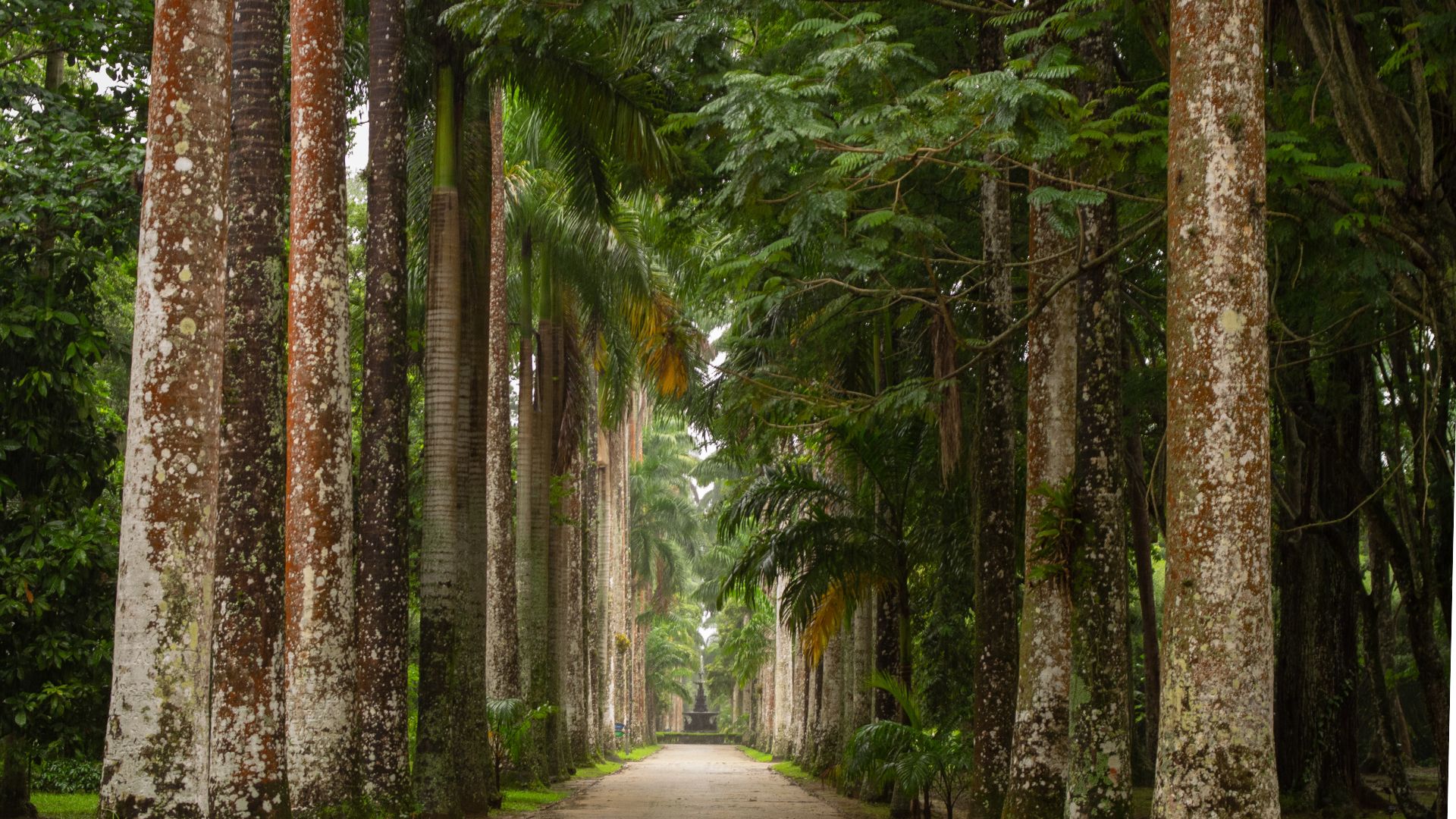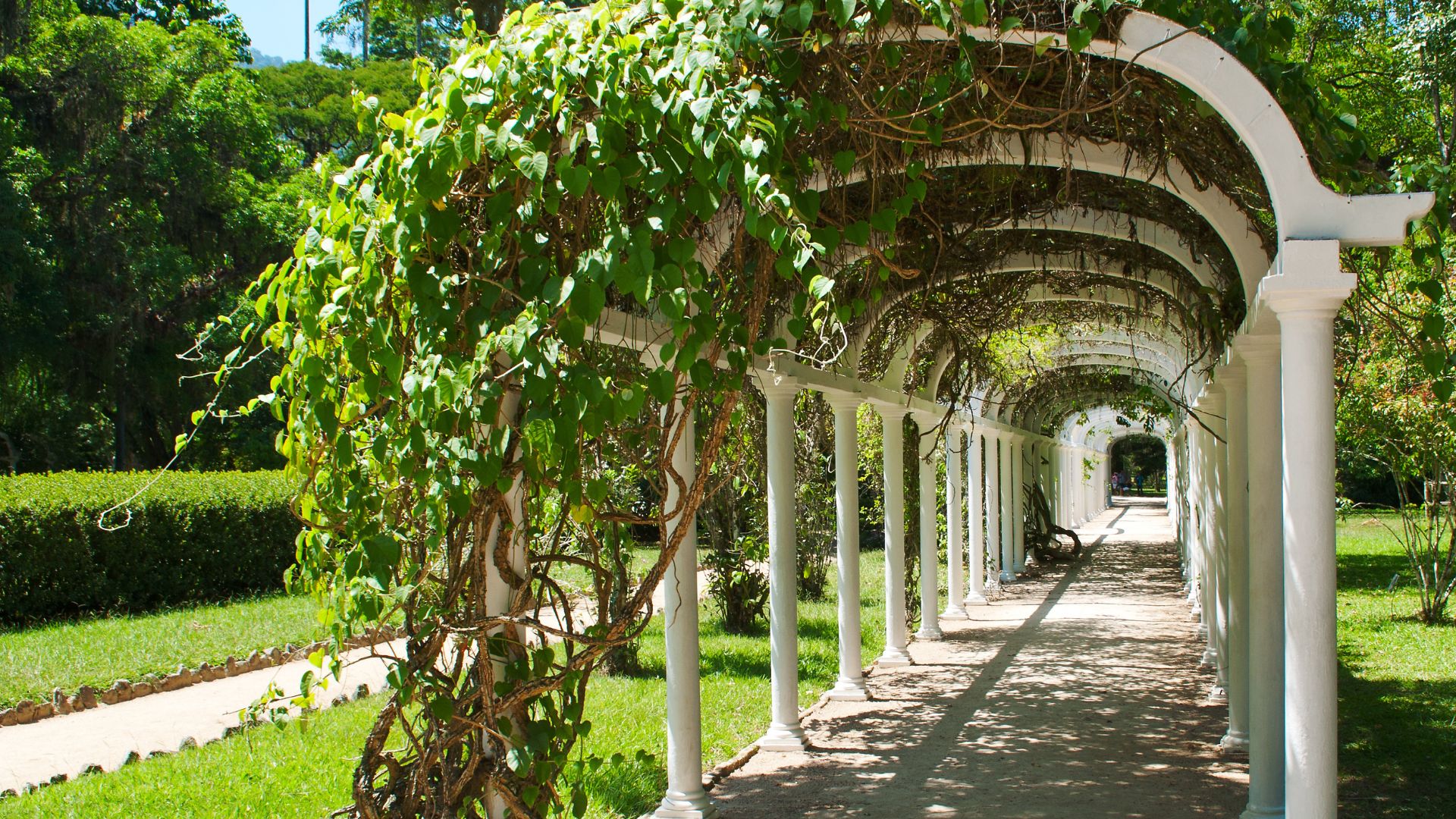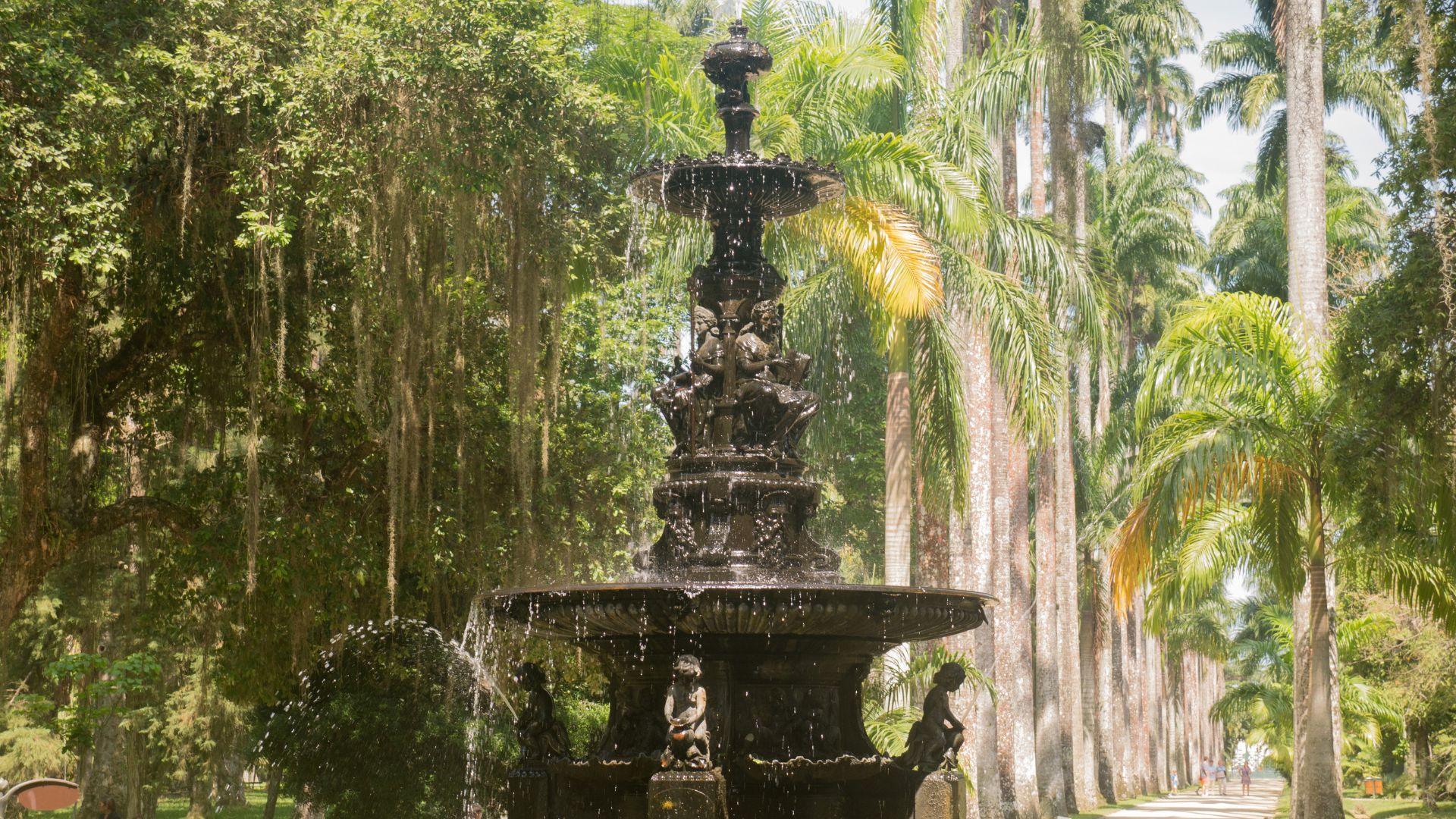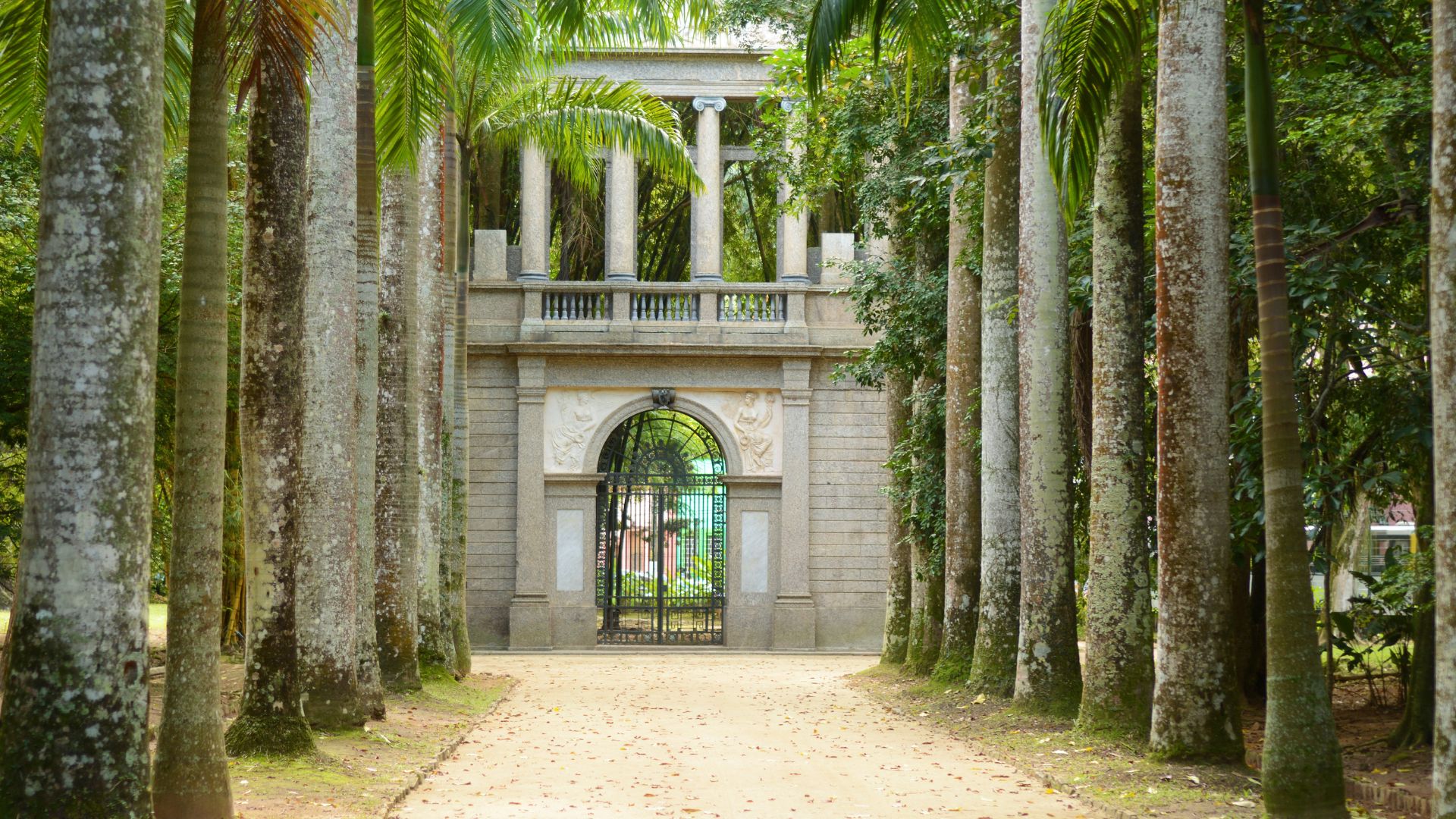The Jardim Botânico in Rio de Janeiro is a calm and beautiful place filled with nature. Tall royal palm trees, some over a hundred years old, line the paths, and the garden is home to one of the most diverse plant collections in the world. It is a peaceful spot that shows off the natural beauty of Brazil.

Highlights:
- Stroll down the majestic Avenue of Royal Palms, where 134 towering trees create one of Rio’s most iconic photo opportunities.
- Explore more than 9,000 specimens representing around 3,500 plant species, including rare Atlantic Forest specimens and exotic plants from around the world.
- Spot wildlife like marmoset monkeys, toucans, and butterflies as they roam freely through this urban sanctuary.
Tickets & Prices
Entry to the Jardim Botânico offers tiered pricing based on residency status.
Foreign visitors pay the standard rate of R$73, while Mercosur residents receive a 25% discount at R$55. Brazilian residents enjoy a significant discount at R$29, residents of the Rio de Janeiro Metropolitan Area pay only R$18, and entry is free for children under 5.
Half-price tickets (50% off) are available for students, seniors, youth up to 21 years, and persons with disabilities (PCD) plus their escorts. These discounts apply to all residency categories, but proper documentation must be presented at entry.
Tours
The Jardim Botânico offers a variety of tours for different interests. The Premium Visit includes a guided electric trolley tour with guided narration and several photo stops, while the Express version offers up to three photo stops.
Guided Walking Tours last an hour and a half, with themed trails on weekends and holidays. These walks happen at 10 AM and 2 PM, giving you a closer look at different parts of the garden. You can also use shared transport to explore on your own.
For something really special, the Night Walking Tour lets you explore the garden after dark, when the plants and sounds feel completely different.

Opening Hours
The Jardim Botânico is open every day of the week, with adjusted hours on Wednesdays. On Monday, Tuesday, and from Thursday to Sunday, the garden is open from 8:00 AM to 5:00 PM. On Wednesdays, it opens later, from 11:00 AM to 5:00 PM. The last entry is always at 4:00 PM.
Jogging is permitted only through the garden’s official morning fitness program, available from 7:00 AM to 8:00 AM, Tuesday to Sunday, with advance registration required.
What to See and Do
From historic landmarks to hidden corners of tropical splendor, these are the things to do that make this botanical sanctuary special.
Walk the Iconic Avenue of Royal Palms
As you enter the garden, you’ll immediately be struck by the magnificent 750-meter-long avenue lined with 134 towering royal palm trees. This isn’t just any collection of palms—every single one is a descendant of the original “Palma Mater,” which was tragically destroyed by lightning years ago.
Top tip: Visit in the early morning when the light filters through the palms at a magical angle, creating perfect photo opportunities without the crowds.
Discover Historic Water Features
The ornate Fountain of the Muses is a beautiful reminder of the garden’s artistic roots. It was first placed at Henrique Lage’s villa in Largo da Lapa and moved to the garden in 1895.
Made in Derby, England, the cast-iron fountain shows four muses, each symbolizing a different art form, like literature, music, and poetry.
What I love most about this spot is the gentle sound of flowing water. It adds a calm background to your visit, mixed with the distant calls of toucans above.
Explore Specialized Greenhouses
The garden’s greenhouses give you a close-up look at different plant types. Each one focuses on a specific group—like orchids with their bright flowers, bromeliads with cool shapes, soft ferns, and insect-eating plants with their wild features.
The orchid greenhouse is especially beautiful, with rare flowers you rarely see in one place. Light shining through the glass adds a calm, dreamy feel as you walk through.
Wander the Japanese Garden
The Japanese Garden offers a calm and quiet escape. Created in 1935 with 65 traditional Japanese plants, it follows classic gardening styles with carefully shaped trees and thoughtful design.
A small bridge over still water, smooth stones, and flashes of koi fish make this spot feel relaxing and balanced. It is usually quiet, making it a great spot to pause and reflect.
Enjoy Wildlife Watching
One of the best surprises in the garden is the amount of wildlife you can see. Next to Tijuca National Park, it’s a natural path for animals. You might spot marmoset monkeys swinging in the trees, black capuchins searching for food, and colorful birds like the channel-billed toucan.
I once spent almost an hour just watching butterflies flutter around the flowers near the Rose Garden. It’s a great reminder that the garden is home to full ecosystems, not just plants.
Find Tranquility in the Atlantic Forest Trail
This newer part of the garden helps protect rare plants from the last flat area of the Atlantic Forest. It’s wilder and more natural than other sections, showing what coastal Brazil looked like before it was built up.
The shaded trail runs from near the cactus zone to the far side of the park, offering a cool, quiet walk even on hot days. With ferns, moss, and native trees all around, the air feels fresher and the temperature cooler.
Visit the Rose Garden for Romantic Moments
The Rose Garden offers seasonal blooms that create a romantic atmosphere perfect for couples or reflective solo visits. The carefully tended roses showcase both classic and Brazilian varieties, with peak flowering typically occurring in spring and early summer.
What makes this area special is how it contrasts with the tropical vegetation found elsewhere in the garden—a reminder of how botanical gardens serve as living museums of global plant diversity.
Explore the Historic Pacheco Leão House
The Pacheco Leão House is a quiet, historic spot inside the garden that gives you a look into life from the past. Named after Dr Antonio Pacheco Leão, a key figure in the garden’s history, the house shows off old furniture and small exhibits that tie science and culture together.

Directions
You can reach the Jardim Botânico in a few easy ways. Take the Metro to Botafogo Station, then hop on the blue Metrô na Superfície bus, toward Jardim Botânico. Get off at Jardim Botânico Baixo Gávea and walk about 5 minutes north to the entrance.
Uber and taxis are also a simple and reliable option from most parts of Rio.
For a more scenic route, rent a bike or electric scooter and enjoy the quiet streets of the Jardim Botânico neighborhood before entering the garden. It is a fun way to explore nearby spots at your own pace.
Nearby Places
Parque Lage: Right next to the garden, this historic park has a beautiful mansion that now hosts the School of Visual Arts. The courtyard and pool offer great photo spots, especially with Christ the Redeemer in the background.
Tijuca National Park: Just beyond the garden, this huge urban forest is full of hiking trails, views, and waterfalls. It is a wilder, more adventurous experience compared to the calm of the garden.
Lagoa Rodrigo de Freitas: This lovely lagoon has paths for walking and biking, boat rentals, and plenty of places to eat by the water. The sunset views with mountains behind are unforgettable.
Corcovado and Christ the Redeemer: Not far from the garden, this world-famous statue is easy to add to your day. You can even spot it from parts of the garden. It is a great way to round out your Rio visit.
Did you know that: (5 Interesting Facts!)
- All 134 royal palm trees lining the garden’s famous avenue are descendants of a single tree, the “Palma Mater,” which was destroyed by lightning.
- The garden originally served as a commercial nursery when established in 1808, testing which foreign plant species could thrive in Brazil’s climate for potential economic benefit through trade.
- A gunpowder factory once operated on the garden grounds during its early days, creating an unusual contrast to its peaceful botanical mission.
- The garden is home to over 9,000 plant specimens, representing around 3,500 plant species, making it one of the most diverse botanical collections in the world.
- When the Portuguese Royal Family fled to Brazil in 1808, King John VI wanted to “bring the world to Brazil,” importing thousands of plant species from around the globe, many of which still grow in the garden today.

History:
- 1808: Jardim Botânico was established by King John VI of Portugal following the Portuguese Royal family’s arrival in Brazil, initially intended as both a conservation area and a commercial garden.
- 1811: The garden opens to the public, transitioning from purely royal grounds to a space for scientific study and public enjoyment.
- 1825: After Brazilian independence, the garden shifts its focus to research and conservation of native Brazilian plant species.
- 1895: The ornate Fountain of the Muses is relocated from Largo da Lapa to the garden, becoming one of its iconic features.
- 1935: The Japanese Garden is established with a donation of 65 typical Japanese plant species, adding cultural diversity to the botanical collection.
- 1937: The garden is officially designated as a research institution focused on Brazilian flora.
- 1938: The Avenue of Royal Palms achieves its current form, becoming the garden’s most recognizable feature.
- 1991: Declared a Biosphere Reserve by UNESCO, recognizing its importance to conservation efforts.
- 2008: Celebrates its bicentennial with expanded conservation programs and international partnerships.
- Present Day: Continues to serve as both a major tourist attraction and an important research center for botanical science and conservation.
FAQ
When is the best time to visit Jardim Botânico?
Early morning (8-10 AM) offers the most pleasant experience with cooler temperatures and fewer visitors. The garden is also particularly beautiful during spring (September-November) when many plants are flowering and the weather is mild.
Are there restaurants or cafes in the garden?
Yes, there are café options within the garden where you can enjoy refreshments and light meals. They’re perfectly positioned for a mid-visit break, offering shaded seating and a selection of Brazilian snacks and beverages.
Can I bring food for a picnic?
Outside food is permitted in designated areas, but sitting directly on the grass is prohibited. Several picnic tables and benches are available throughout the garden for visitors who bring their refreshments.
How much time should I allow for a visit?
A thorough visit requires at least 2-3 hours, though many visitors spend half a day exploring.
Is the garden accessible for people with mobility issues?
While some paths are wheelchair accessible, the garden’s historical nature means not all areas can be easily reached. Electric trolleys are available to help visitors with mobility challenges navigate the main sections of the garden.
Map & Address
Jardim Botânico
Located in the South Zone of Rio de Janeiro, approximately 10 km from the city center and 30 minutes from Copacabana Beach by car.